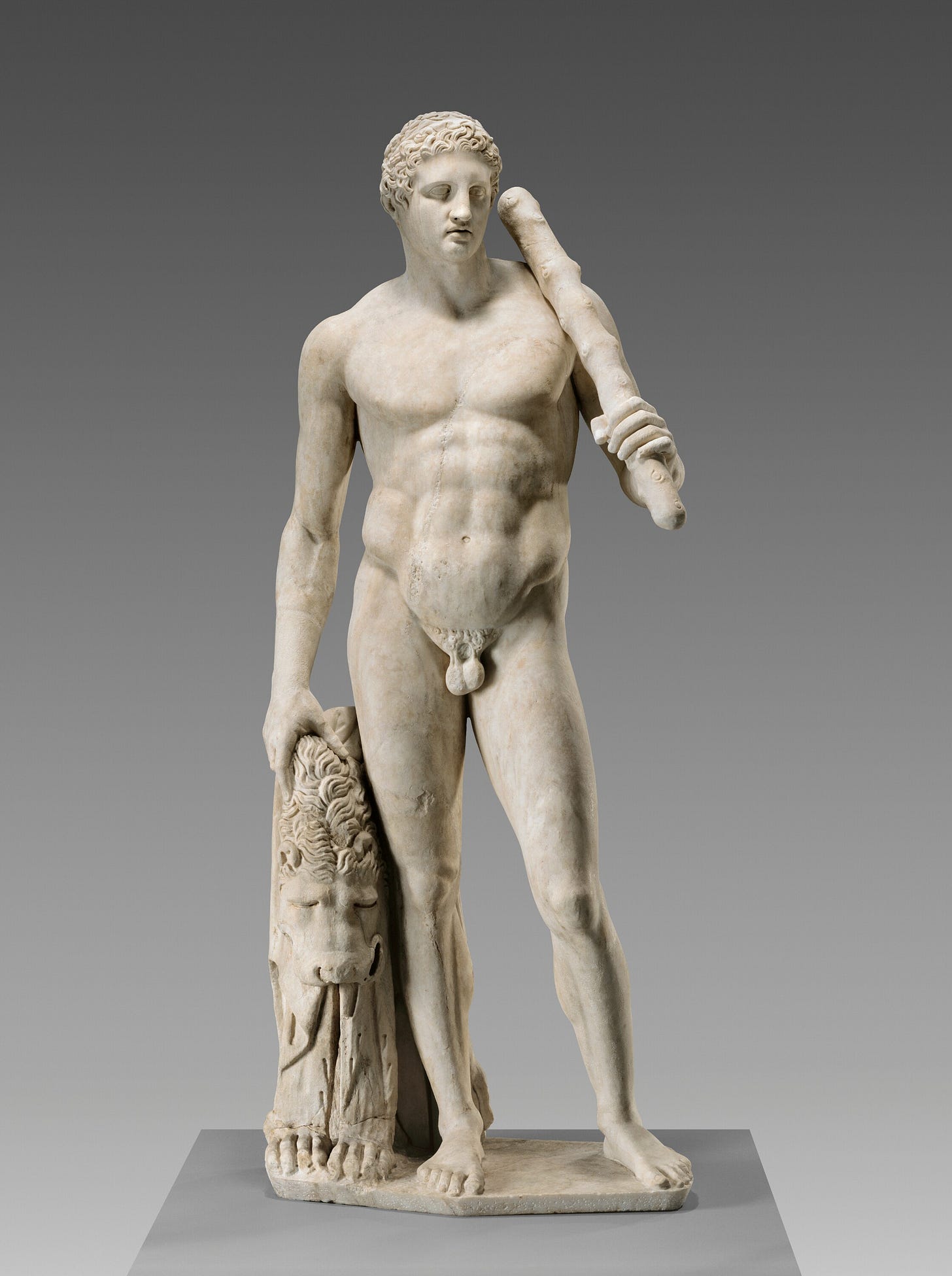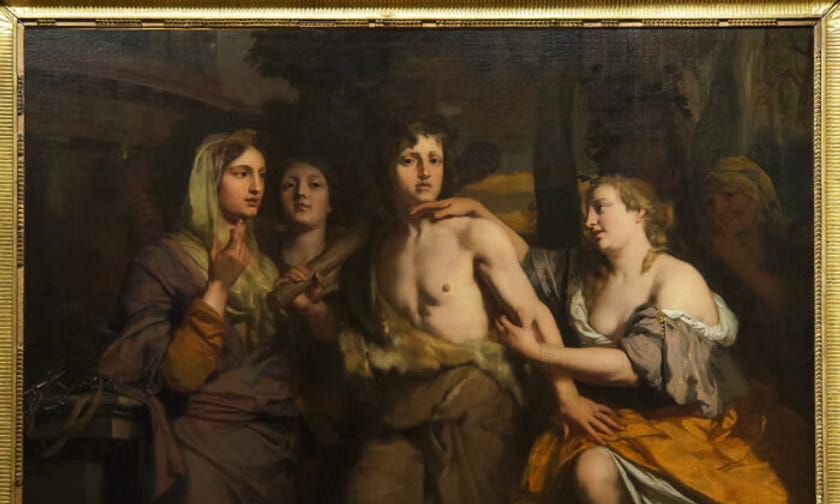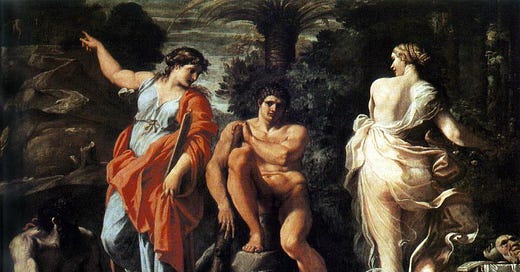Heracles: Hero, God, and...Philosopher?
Heracles' infamous choice between the good life and the easy one in mythology and philosophy
Welcome to this week’s edition of Reading Art!
When you think of the hero Heracles, you probably think of the quintessential Greek hero, someone who fights monsters and defies the odds to embrace a glorious destiny. Of course, Heracles had a tortured life as well; forced to embark on the Twelve Labors by his wicked stepmother, the goddess Hera, who also drove him insane and thereby caused him to unwittingly murder his wife and children, he never had it easy. Oh, and then after all of that, his next wife accidentally poisoned him so that all his skin began to burn off and he was in such terrible agony that he began to burn himself alive, at which point his father Zeus finally—finally!—made him a god.

In light of this constant misery, it became clear to the ancient Greeks that Heracles must have had a pretty incredible amount of resilience. As a result, he wasn’t just a popular mythological figure and deity to be worshipped: he actually became a proto-philosopher figure, the original example of someone bearing the vicissitudes of fortune with equanimity and perpetual endurance. In particular, Heracles was especially popular with the Stoics, who saw him as one example of someone who was able to retain a sense of inner calm and peace no matter what the external circumstances.
The thinking here is that someone would have to have exceptional inner wisdom, discipline, and virtue to bear all the things that Heracles did. Over time, a new sort of archetypal myth emerged, crystallizing the one moment in which Heracles was required to choose this identity of utter goodness and excellence: the classic “Choice of Heracles.”
In Xenophon’s Memorabilia, which is Xenophon’s recollections of the teachings of his mentor Socrates, Xenophon recounts a time in which Socrates was telling this Heracles myth as an allegory of philosophical virtue. To make his point, Socrates quoted an earlier intellectual, Prodicus, who told the story of how Heracles made the difficult choice that all young people must make: whether their life will be good or bad (2.1.21-33). Socrates wasn’t a Stoic, because that school of philosophy didn’t exist yet, but he is often claimed as the unofficial founder of that school, owing to his teachings on emotion, suffering, and the acceptance of one’s fate.
Anyway, back to Prodicus’ allegory: as the story goes: one day, Heracles went to ponder his life’s direction in solitude. Here, he was met by two women, the personification of Vice (Kakia in Ancient Greek) and Virtue (Arete in Ancient Greek). Virtue was a humble and modest women with gentle yet firm manners. She admitted that her path was a difficult and steep one to traverse, but at the top there was endless glory and joy to be had.
Vice (who deceptively introduced herself as Happiness) was a lot more colorful. A beautiful woman dressed in bright and showy clothes as well as lots of makeup (a sure sign of her dissoluteness), she offered a path that was a flat, easy one, filled with all kinds of fun along the way. What lie at the end of that path, you might wonder? She was a little vague on the outcome and couldn’t make any promises—she was here for the vibes only, not the future planning. The point was that he’d have fun immediately! No delayed gratification, and no more Labors or accidental murdering of family members.
Virtue makes the point that nothing good in life comes easy; if you want something, you have to work for it. Heracles found this argument persuasive. Although he was tempted by Vice, Heracles summoned his inner strength and went with Virtue. Indeed, at the end of his journey, Heracles was rewarded with immortality.
The idea behind this myth or allegory is that every person is faced with a moment in which it is necessary to decide whether Virtue or Vice will be the guide and teacher in their life, as if it were a single moment in which it would even be possible to make this decision. I think that’s what fascinates me so much: the idea that a philosophical life of virtue is decided upon in a single moment, and from there on out we’ve made our choice. In my own life, I’ve come to understand that we make these kinds of decisions continuously—if indeed there can be such a clear-cut differentiation made between Vice and Virtue. But allegory doesn’t do well with grey areas.
Cicero seemed to understand this point, though. For example, in De Officiis (On Duties or Obligations), Cicero (a fan of Stoic philosophy) notes that it is unfortunate in many ways that young men do not exactly get a “choice of Heracles” moment. Instead, they have to decide their life’s path at a relatively young age and without the benefit of experience (1.117-118).
It’s also important to note that, in the eyes of ancient authors, this choice is one that is faced by men, not women. That isn’t to say that they didn’t think women could be virtuous. On the contrary, there were clearly defined ways in which a woman could embody arete. We can see this in the way that Virtue is characterized: as the woman who perfectly conforms to societal expectations for women. But the actual heroic and philosophical choice seems to belong to men only. Of course, women do appear in the story, as the personifications of Vice and Virtue. This might be explained by the fact that, for the male gaze, the female figure is more enticing, compelling, and mysterious.
Let’s turn to art. This allegorical and mythological scene absolutely fascinated early modern artists, who were no doubt also interested with the parallels to Christian thought and the ongoing struggle between Heaven and Hell.
I love this piece by Carracci because it’s not immediately obvious to me which one is Virtue and which one is Vice. At first glance, you might think the temptress is the one on the left, in her bright clothing, while Virtue would be the one in pure white. But you quickly see the reverse is true: Vice is not wearing the white traditionally associated with purity and goodness, but a sheer gown that points to her moral deficiency. Her oblique gaze isn’t modesty, but just the opposite.
Virtue points upward to the steep, narrow, and winding path Heracles will have to traverse to get to his ultimate reward. If you squint, you can see that there’s a horse at the top of the mountain, which is Pegasus, signifying the glory Heracles will win if he chooses this path.
The hero himself remains pretty impassive, which is interesting. He’s not immediately turning to Virtue, but he hasn’t exactly been swayed by Vice either. Carracci gets that perfect moment of deliberation in which things could go either way.
From around the same time period is this much more colorful variation, Veronese’s take on the myth:

We actually don’t see Vice’s face, which is funny considering her alluring beauty is a big part of her characterization. Carracci doesn’t show Vice’s face either. Maybe they’re making the point that we can’t necessarily recognize Vice when we see it; she’s more of a vibe than anything else, something that has to be picked up on. The overt appearance is deceptive and ever-shifting.
In this example, Vice is getting up from a throne that is supported by a statue of a woman, identified as a Sphinx. The blade through her exposed breast provides ample commentary on what we’re supposed to think about that. Vice has ripped Heracles’ stocking (I find it kind of hilarious that he’s in courtly sixteenth-century garb), and he’s retreating into the welcoming arms of Virtue, who is wearing the olive crown of victory and the poetic art. Up in the corner, the temple partly in view has the inscription [HO]NOR ET VIRTUS [P]OST MORTE FLORET (Honor and Virtue Flourish after Death).
It seems to me that Dishonor and Vice can also flourish after death, but the point is clear.
Finally, from about a century later, we have this portrayal of the myth by Gerard de Lairesse:

Heracles looks much younger here, more like the young men that Socrates and Cicero mention as being at a critical juncture in their lives, the moment it comes time to choose their path. Virtue is lecturing Heracles on her, well, virtues, and she’s accompanied by another female figure. There’s Vice on the right, copping a feel to try and tempt the hero. It should be noted that Heracles’ wandering hand seems to indicate that this Heracles is a bit more undecided than in the other examples, and his face is turned toward Vice.
This allegorical myth was adopted by authors as well in addition to artists. For example, Raphael’s father, Giovanni Santi, wrote an epic poem in honor of the Duke of Urbino and included a brief recap of the myth in that poem’s prologue.
The myth was not above being parodied, either. In ancient times, the satirical author Lucian, writing in the second century, wrote an autofictive text called The Dream. Here, Lucian describes a time in his early life when his family wanted him to learn the art of metalworking so that he would have a lucrative trade. Unfortunately, Lucian did not have an aptitude for the field, and went home in tears one day. Falling asleep that night, Lucian was visited by two women.
One of them was Techne (Art), the skill/art of metalworking that was supposed to be his vocation. This was a dirty and masculine-looking woman who looked like she came straight from the forge, Lucian notes. Her main argument was that Lucian should stay in his hometown, not rock the boat, and do something useful with his hands. The other woman was Eloquence, a beautiful women in opulent clothing who promised that, if Lucian should follow her, he would see the world and become both famous and wealthy.
In a humorous twist on the narrative, Lucian chooses Eloquence, who is clearly modeled on Vice, and goes on to have a wonderful career as a traveling rhetorician and sophist.
Although this is clearly a satirical work, I do think that it brings to bear a serious point: we have to decide what works best for us, and preconceived ideals of Vice and Virtue are often determined by what society thinks is best. Lucian is sometimes thought of as a Stoic, although he never states that he belongs to one or the other philosophical school, and it’s interesting that he puts himself in the role of Heracles, the proto-Stoic who bore his fate with patience and steadfastness. And yet he also went in pursuit of glory, suggesting that a philosophical life need not be devoid of public recognition, wealth, honor, etc. (now this is starting to sound Epicurean—a topic for another time).
Thank you for reading this week’s newsletter!
Stoic philosopher Seneca the Younger once wrote facilis est ad beatam vitam via—The Path to a Happy Life is Easy. This seems to run counter to everything we’ve discussed here so far. But I think that, in many ways, Seneca’s words are correct, even if he didn’t mean them in this exact way: it’s less about a fraught choice between rigid categories of good and bad and more about following the calling of your heart. Although, as Cicero notes, we might not have all the experience we need to make truly informed choices at every turn, we simply do the best we can.
Thank you so much for reading! I would love to hear from you in the comments. Take care until next time.
MKA




